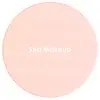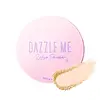What's inside
What's inside
 Key Ingredients
Key Ingredients

 Benefits
Benefits

 Concerns
Concerns

 Ingredients Side-by-side
Ingredients Side-by-side

Talc
AbrasiveSilica
AbrasiveCetyl Ethylhexanoate
EmollientBoron Nitride
AbsorbentNylon-12
Triethoxycaprylylsilane
Salicylic Acid
MaskingWater
Skin ConditioningPhenoxyethanol
Preservative1,2-Hexanediol
Skin ConditioningEthylhexylglycerin
Skin ConditioningMethylpropanediol
SolventHamamelis Virginiana Extract
AntiseborrhoeicHydroxyacetophenone
AntioxidantHexylene Glycol
EmulsifyingCorn Starch Modified
AbsorbentSilica
AbrasiveSynthetic Fluorphlogopite
Mica
Cosmetic ColorantPhenoxyethanol
PreservativeMagnesium Myristate
Dimethicone
EmollientTocopheryl Acetate
AntioxidantTriethoxycaprylylsilane
Titanium Dioxide
Cosmetic ColorantPhenyl Trimethicone
Skin ConditioningParfum
MaskingAluminum Hydroxide
EmollientEthylhexylglycerin
Skin ConditioningCyclopentasiloxane
EmollientPolymethylsilsesquioxane
Hydrated Silica
AbrasiveHydrogen Dimethicone
Ascorbic Acid
AntioxidantArbutin
AntioxidantEthylhexyl Palmitate
EmollientSaccharomyces/Rice Ferment Filtrate
Skin ConditioningWater
Skin ConditioningHydrogenated Polyisobutene
EmollientGlycerin
HumectantHydrogenated Lecithin
EmulsifyingCalendula Officinalis Flower Extract
MaskingCeramide NP
Skin ConditioningCaprylyl Glycol
EmollientPropylene Glycol
HumectantChrysanthellum Indicum Extract
Skin ConditioningButylene Glycol
HumectantTrihydroxystearin
Skin Conditioning1,2-Hexanediol
Skin ConditioningSodium Hyaluronate
HumectantGlucomannan
Skin ConditioningCI 77891
Cosmetic ColorantCI 77492
Cosmetic ColorantCI 77491
Cosmetic ColorantCorn Starch Modified, Silica, Synthetic Fluorphlogopite, Mica, Phenoxyethanol, Magnesium Myristate, Dimethicone, Tocopheryl Acetate, Triethoxycaprylylsilane, Titanium Dioxide, Phenyl Trimethicone, Parfum, Aluminum Hydroxide, Ethylhexylglycerin, Cyclopentasiloxane, Polymethylsilsesquioxane, Hydrated Silica, Hydrogen Dimethicone, Ascorbic Acid, Arbutin, Ethylhexyl Palmitate, Saccharomyces/Rice Ferment Filtrate, Water, Hydrogenated Polyisobutene, Glycerin, Hydrogenated Lecithin, Calendula Officinalis Flower Extract, Ceramide NP, Caprylyl Glycol, Propylene Glycol, Chrysanthellum Indicum Extract, Butylene Glycol, Trihydroxystearin, 1,2-Hexanediol, Sodium Hyaluronate, Glucomannan, CI 77891, CI 77492, CI 77491
Ingredients Explained
These ingredients are found in both products.
Ingredients higher up in an ingredient list are typically present in a larger amount.
1,2-Hexanediol is a synthetic liquid and another multi-functional powerhouse.
It is a:
- Humectant, drawing moisture into the skin
- Emollient, helping to soften skin
- Solvent, dispersing and stabilizing formulas
- Preservative booster, enhancing the antimicrobial activity of other preservatives
Ethylhexylglycerin (we can't pronounce this either) is commonly used as a preservative and skin softener. It is derived from glyceryl.
You might see Ethylhexylglycerin often paired with other preservatives such as phenoxyethanol. Ethylhexylglycerin has been found to increase the effectiveness of these other preservatives.
Phenoxyethanol is a preservative that has germicide, antimicrobial, and aromatic properties. Studies show that phenoxyethanol can prevent microbial growth. By itself, it has a scent that is similar to that of a rose.
It's often used in formulations along with Caprylyl Glycol to preserve the shelf life of products.
Silica, also known as silicon dioxide, is a naturally occurring mineral. It is used as a fine, spherical, and porous powder in cosmetics.
Though it has exfoliant properties, the function of silica varies depending on the product.
The unique structure of silica enhances the spreadability and adds smoothness, making it a great texture enhancer.
It is also used as an active carrier, emulsifier, and mattifier due to its ability to absorb excess oil.
In some products, tiny microneedles called spicules are made from silica or hydrolyzed sponge. When you rub them in, they lightly polish away dead skin layers and enhance the penetration of active ingredients.
Learn more about SilicaTriethoxycaprylylsilane is a silicone used to bind and stabilize ingredients.
As an emulsifier, it helps prevent ingredients from separating. This can help elongate the shelf life of products.
Triethoxycaprylylsilane is often used to coat mineral sunscreens ingredients to help give a better feel. It also helps reduce oxidative stress in sunscreens.
Learn more about TriethoxycaprylylsilaneWater. It's the most common cosmetic ingredient of all. You'll usually see it at the top of ingredient lists, meaning that it makes up the largest part of the product.
So why is it so popular? Water most often acts as a solvent - this means that it helps dissolve other ingredients into the formulation.
You'll also recognize water as that liquid we all need to stay alive. If you see this, drink a glass of water. Stay hydrated!
Learn more about Water